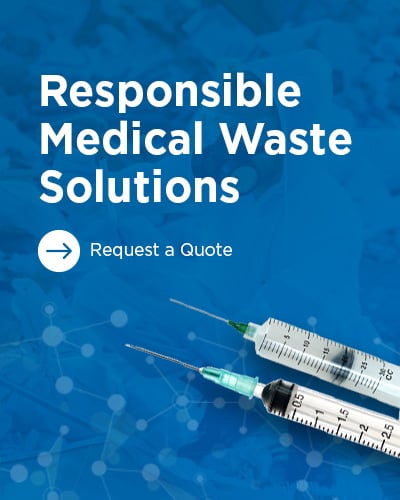Medical waste disposal can be an expensive reality for any facility that handles bio-hazardous materials. Regulations created both by OSHA and the State identify what materials can be labeled as medical waste, and the over-classification of this waste often leads to a facility overpaying for its disposal. However, there are ways to reduce these costs associated with the disposal of medical waste. In this blog we will cover both:
- What wastes are considered to be a medical waste?
- How can a facility lower the cost of disposing of medical waste?
What Wastes are Considered to be Medical Waste?
![]()
According to the World Health Organization, there are eight types of medical waste:
- Infectious waste: waste contaminated with blood and other bodily fluids (e.g. from discarded diagnostic samples), cultures and stocks of infectious agents from laboratory work (e.g. waste from autopsies and infected animals from laboratories), or waste from patients with infections (e.g. swabs, bandages, and disposable medical devices);
- Pathological waste: human tissues, organs or fluids, body parts, and contaminated animal carcasses;
- Sharps waste: syringes, needles, disposable scalpels, blades, etc.;
- Chemical waste: for example solvents and reagents used for laboratory preparations, disinfectants, sterilants, and heavy metals contained in medical devices (e.g. mercury in broken thermometers) and batteries;
- Pharmaceutical waste: expired, unused and contaminated drugs and vaccines;
- Cytotoxic waste: waste containing substances with genotoxic properties (i.e. highly hazardous substances that are, mutagenic, teratogenic or carcinogenic), such as cytotoxic drugs used in cancer treatment and their metabolites;
- Radioactive waste: such as products contaminated by radionuclides including radioactive diagnostic material or radiotherapeutic materials; and
- Non-hazardous or general waste: waste that does not pose any particular biological, chemical, radioactive or physical hazard. (1)
Out of all the waste created by facilities, only about 15% is actually considered hazardous. (1) This means that an office could potentially be overpaying for a medical waste disposal system, simply due to the over-classification of its waste. Each state has clear definitions for what materials qualify as hazardous, so it’s vital for an organization to clearly understand the expectations put before them when it comes to properly dispose of medical waste.
How can a Facility Lower the Cost of Disposing of Medical Waste?
A common question we are asked is How Much Does Medical Waste Disposal Cost? Thankfully, there are ways for a facility to reduce the cost of their medical waste disposal. These include: Conducting regular training with staff, having a medical waste management plan that clearly states what items will be classified as “medical waste”, and utilizing a mail-back system.
It’s important for all staff to be aware of which materials they dispose of will be classified as hazardous. Regular training can reduce this risk of improper waste disposal. For example, a dental office generates sharps waste in the form of cap needles, syringes, and scalpel blades that must be discarded using proper sharps container disposal. However, they do not generate bio-hazardous waste simply because the volume of “blood” in their waste is not enough to classify the waste as bio-hazardous, therefore it can be discarded in the trash.
Creating a medical waste management plan that clearly states what items will be classified as “medical waste” is imperative to a facility’s proper disposal of waste. In the state of Texas, “medical waste” is defined as, “Treated and untreated special waste from health care-related facilities that is comprised of animal waste, bulk blood, bulk human blood, bulk human body fluids, microbiological waste, pathological waste, and sharps”. (2) For instance, sharps (syringes, needles, disposable scalpels, blades, etc.), should be discarded using the proper bio-hazard sharps container disposal method. (3)
Once a facility’s staff has been made aware of what materials qualify as hazardous and a medical waste management plan has been created, an office has the option of utilizing a mail-back system for its medical waste. For example, sharps container disposal methods are designed to safely contain any sharps materials while they are transported to a waste facility. Small quantity generators of waste like dentists and small healthcare facilities can benefit by utilizing a mail-back system. This reduces the cost of disposal significantly by eliminating long-term contracts, monthly fees, and fuel surcharges.
Medical waste disposal doesn’t have to be an expensive endeavor for any facility that handles bio-hazardous material. Simply developing a waste management plan and educating staff can eliminate many of the errors associated with the over-classification of waste materials. PureWay is a medical waste mail back manufacturer and can provide you with several options for disposal of medical waste, biomedical waste, sharps containers, and more. Mail-back systems can significantly minimize the cost of medical waste disposal. To find solutions for mail-back waste disposal, click HERE.
Sources:
(1) “Health-Care Waste.” World Health Organization, World Health Organization, 8 Feb. 2018,
www.who.int/news-room/fact-sheets/detail/health-care-waste.
(2) “Texas Administrative Code.” Texas Administrative Code, texreg.sos.state.tx.us/public/readtac$ext.TacPage?sl=R&app=9&p_dir=&p_rloc=&p_tloc=&p_ploc=&pg=1&p_tac=&ti=30&pt=1&ch=326&rl=3.
(3) "Sharps." McGraw-Hill Concise Dictionary of Modern Medicine. 2002. The McGraw-Hill Companies, Inc. 24 Sep. 2018 https://medical-dictionary.thefreedictionary.com/sharps.





